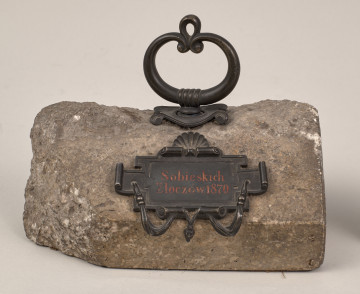
Paperweight
XIX century
Castle Museum in Łańcut
Part of the collection: Broń, instrumenty, varia
Human memory is unreliable, it is better to write down your thoughts so that they do not fly away. Writing is an art that is one of the milestones of human civilization.
All you need to write is a blank sheet of paper, a pen, ink (more and more often replaced by word processors, mice, etc.) and you can create another national epic. To make it not too easy, the ink stains the sheets of paper, stains the fingers, but tissue paper can remedy this. Once we have dealt with the ink and stains, we sit down and "pour" our thoughts onto paper. We're sitting, we're writing with enthusiasm, and then someone walks in the room, opens the door, opens the window, and this treacherous wind blows the written and unwritten pages to the floor, mixing everything up. The poor creator has to pick everything up, often on his knees, and his back hurts from sitting. When he has already collected the pages, it turns out that they are mixed, and they were forgotten to be numbered and, to make matters worse, a few pages were crumpled during the collection and in fact they should be rewritten. Finally, we manage to put the written pages in order and we sit down to continue our work, and then someone comes in on an urgent matter, someone opens the second window and again we have confetti from our written pages and we start collecting our written "golden thoughts" from the beginning. After a few such visits, we forget our own thoughts, discouragement creeps in, and because of such a small zephyr, some "epoch-making" work may not be created. And yet it was enough (with the exception of locking the doors and windows) to hold the blank and written pages with some heavy object, but not so heavy as to destroy the sheets of paper. Such an object is a paperweight, which is sometimes a small work of art in the form of figurines, plaques made of alabaster or glass, or other materials that are pleasing to the eye. They can also be very simple elements, such as various types of stones collected during trips from places sentimentally close to the collectors or related to the history of family or country. In this way, the paperweight became an indispensable desk equipment next to the inkwell, pounce pot, tissue paper, pen holder, lamp, and just like them, it took on different forms and shapes depending on the fashion prevailing in art at a given period. Paperweights, thanks to their form/shape and the material they are made of, complement the décor of the desk – those made of wood evoke the impression of warmth, those made of metal, especially precious metals, add majesty, and those made of glass or crystal, thanks to reflections, give the character of ephemerality like written thoughts. The most ordinary ones in the form of stones remind us of the places we have been to. They can also remind us of past centuries and events that constitute our history and heritage.
The currently discussed paperweight with inv. no. S3616MŁ is simply a lump of flint with an unusual form of a cylinder expanding upwards, and referring to the shape of the capital of an ancient column. The colours of the stone are maintained in various shades of bronze, and the unpolished walls cause the refraction of sunlight, which additionally increases the aesthetics of the exhibit.
Flint is a sedimentary rock associated with human history from the beginning. It was a very popular, easily available material from which the first tools were made. In Poland, flint tools were made as early as in the Palaeolithic period, and the stone came from the vicinity of Cracow. According to research, flint was mined on an "industrial" scale in the area of Ostrowiec Świętokrzyski (Krzemionka). From flint our ancestors made tools used for hunting, such as axe blades, arrowheads for primitive spears and tools used in the "household". With the advent of the Bronze and Iron Ages, the usefulness of stone tools disappeared, although flint was still used for striking a fire. Because of the property of lighting a fire, flint was used in the eighteenth and nineteenth centuries, when it became an indispensable part of a flintlock, and in the twentieth century a part of a lighter. In the present years, flint, and especially the striped variety, has become a fashionable and sought-after material for jewellery making.
Currently, paperweights, including the flint one, are exhibited at the permanent exhibition of the Museum – Łańcut Castle in the so-called Ordynat's Office.
Przemysław Kucia
Author / creator
Object type
pamiątki
Material
flint
Owner
Muzeum - Zamek w Łańcucie
Identification number
Location / status